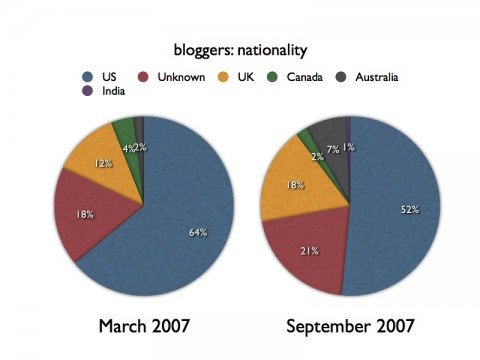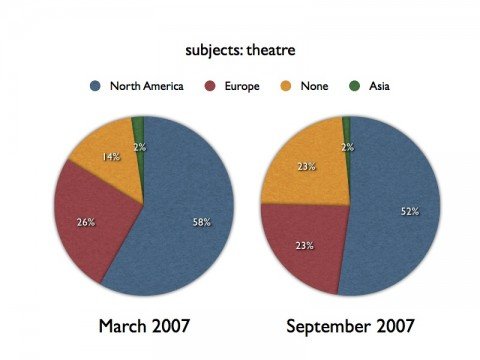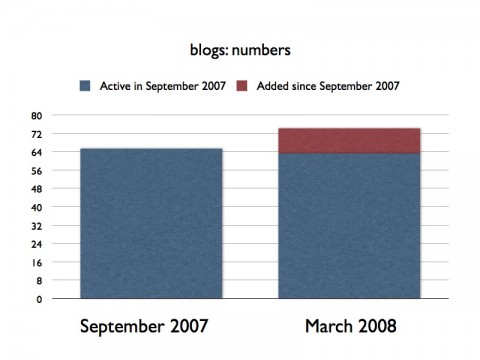[Cross-posted at Revise and Dissent.]
Six months ago, I used Cliopatria’s list of history blogs to assess the state of the military portion of the historioblogosphere. My original plan was to do this every year, but because things move fast online I’ll update it every six months instead. I won’t waffle on too much about my methodology (if it can be called that!); for that, please refer to the original post, as well as for the plots from March 2006.
First, let’s look at the number of blogs in the military historioblogosphere. This increased by just over 50% in six months, i.e. an annualised rate of more than 100%, which is considerably faster growth than in the year to March 2007. This is now only slightly slower than the rate of growth of the blogosphere as a whole, which as of April 2007 was doubling every 320 days (as measured by Technorati. Of course that rate may have changed by now). Some 13% of the blogs in the March 2007 list don’t appear in the current version, which, sustained over a year, would be a touch higher than the churn rate last time.

The nationality of bloggers in the military historioblogosphere. The American dominance, though still a majority, has receded somewhat (although as before, most of the 20% of unknowns are US Civil War bloggers and so are likely to be Americans). British bloggers now represent about a sixth, instead of an eighth, of the total number of bloggers. And Australian bloggers are up from 2% (i.e., me) to 7%! The reason for this is largely the emergence of institutional blogs, such as Osprey and UKNIWM in the UK, and the AWM’s blogs in Australia (which I’ve counted as one blog, as that’s the way it’s listed at Cliopatria). These are all group blogs, which means they count for much when adding up numbers of individual bloggers.
The gender of bloggers in the military historioblogosphere. The number of female bloggers is still only 10%, but at least is nearly double the proportion of six months earlier. Again, this is largely because of the rise of institutional blogs: the majority of women who blog on military history now do so as part of a group blog (7) and not on their own (3).
The periods covered by blogs in the military historioblogosphere. There’s not a lot of change here; mainly greater diversity. (Especially since “None” covers blogs which range all over time.)
The theatres covered by blogs in the military historioblogosphere. Again, the proportions have stayed pretty much the same — basically a bit less North America and a bit more non-specific None.
The wars covered by blogs in the military historioblogosphere. Here, the biggest change is that the proportion of blogs focusing on the World Wars has dropped from about a quarter to a fifth, while those not dealing with any specific war now represent 28% of the whole sample, up from 16%. The American Civil War is still the most popular war, but it has lost its absolute majority.
The top five most popular blogs in the military historioblogosphere, by Technorati rank. I wondered whether I should include this again. After paying closer attention to my own rank in the last few months, I’ve become aware of just how dodgy it is (for example, Technorati counted one link to my blog as coming from four separate blogs!) But as this was the chart which attracted most interest last time, leaving it out would minimise the boost that this post will give to my Technorati ranking :) So I’ll just remind you that these figures should be taken with a large grain of salt.
As in March, Blog Them Out of the Stone Age is the most popular blog in the military historioblogosphere. But only just! Civil War Memory is almost level (in fact, had one more blog linked to it they would be tied). Third is Airminded itself, which has risen about 50,000 places in the Technorati ranks — which is further evidence for the unreliability of this measure, as my stats program tells me that traffic to my site has actually held steady or perhaps even declined a little over the last six months. Next comes Investigations of a Dog, which has slipped a little in the rankings (in fact, most of the blogs in the sample have: with an expanding blogosphere, you have to keep running faster just to stand still). And in fifth position, About.com’s Military History blog has been displaced by Military History Podcast. This has been around for a couple of years, and it’s particularly noteworthy because its author is still only a teenager! It’s also a good example of the rise of generalist military history blogs, which aren’t tied to any particular historical time or place.
So, the military historioblogosphere is rapidly growing and somewhat more diverse than it was in March 2007; but still dominated by American bloggers writing about the American Civil War. The biggest change, however, has been the increase in institutional group blogs, usually attached to museums but sometimes also to publishers or archaeological projects. No doubt there’ll be a few more of these by March 2008 …
![]() This work is licensed under a Creative Commons Attribution-NonCommercial-NoDerivatives 4.0 International License.
Permissions beyond the scope of this license may be available at http://airminded.org/copyright/.
This work is licensed under a Creative Commons Attribution-NonCommercial-NoDerivatives 4.0 International License.
Permissions beyond the scope of this license may be available at http://airminded.org/copyright/.










I’m still not sure what to make of Technorati rankings. On one hand I think my ranking deserves to be lower than it was because the quality and frequency of my posts has gone down since March, but on the other, traffic seems to be the same as it always was – usually around 50 unique visits a day, which isn’t really a lot. But my reputation seems to be doing well regardless of my posts or Technorati rank. In the last few weeks I’ve had 3 offers of review copies of books, something which had never happened before. Newer bloggers tend to look up to more established bloggers, which can lead to new blogs talking about how great IoaD is even if it isn’t looking particularly great at the time they’re writing. Although things move fast in the blogosphere it can also be quite conservative in some respects. Once you’ve acquired a reputation it can last a long time (possibly independent of Technorati rankings) even if you don’t do anything to maintain it.
You’re right about the conservatism, I can think of a few blogs which I still think highly of, even though they now are much less active than when I started blogging. Perhaps the Technorati ranks should be smoothed so that they don’t change so quickly over time. Or the number of “blog reactions”, which captures more of how much a blog is discussed (as opposed to just sitting in somebody’s blogroll). But I guess that would fluctuate too.
The TTLB rankings could be used as an alternative. But although the actual rankings are quite different (BTOOTSA and CWM are miles apart, not neck and neck), the order is currently the same for the top 4 (Military History Podcast doesn’t seem to be there). Of course I didn’t check the whole sample so there could be more significant differences in there.
Hi Brett. Interesting reading. I did quite a lot of research on the web for aviation blogs before starting my own blog and site at the Spitfire Site last summer. I was surprised to see how few aviation history blogs were (are) available online, yours being a pleasant surprise in terms of quality and choice of subject (others that I found worth noting being listed in my post here. I would seem that the niche of military history, and particularly aviation, has barely been exploited yet in the blogosphere.
Part of the issue may be that many interesting sites have been made i pre-blog times by people which were less technically aware who preferred to produce their publications as journals or reference websites. Two examples of this may be (now sadly defunct) Chandelle or (likewise defunct) AFV Interiors.
In other words, there’s work to be done. I’m glad to have found your blog.
Pingback: Investigations of a Dog » New Military History Blog
Pingback: THE RUSSIAN FRONT » Military History on the Web
Thanks Martin, and I’m very impressed with what I’ve seen of your blog and site so far! I have also been surprised at the lack of aviation history blogs, given that it’s such a popular subject. I think the technical barrier is probably part of the explanation, though with WordPress.com and so on it’s really very easy these days. It seems that more social forms of communication like forums and mailing lists are preferred by many who might otherwise contribute to the blogosphere. There may also be a generational aspect, with older enthusiasts less inclined to experiment with new technologies.
But anyway, welcome to the blogosphere!
Pingback: Investigations of a Dog » I’ll never stay to say happy anniversary
Pingback: Airminded · State of the military historioblogosphere, March 2008